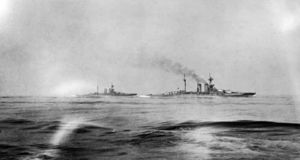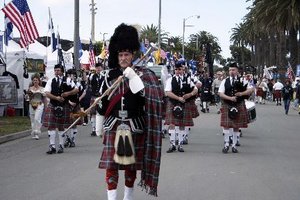“Dreadnought” by Robert K. Massie explains how the great naval arms race between Great Britain and Germany at the dawn of the twentieth century was the biggest single root cause of the beginning of the First World War in 1914.
It has been nearly 100 years now since the beginning of World War I, “the war to end all wars.” The First World War has been the subject of many excellent books in recent years. Most notable are: “The First World War” by Hew Strachan (2004); “The First World War” by John Keegan (2000); “A World Undone: The Story of the Great War, 1914 to 1918” by G.J. Meyer (2007); “The Guns of August” by Barbara Tuchman (1962; Pulitzer Prize winner); and the subject of this review: “Dreadnought: Britain, Germany, and the Coming of the Great War” by Robert K. Massie (1991).
“Dreadnought” by Robert K. Massie is one of the finest works of history I’ve read in many years. Actually, it’s not so much a book about World War I and how it was fought, as it is about what Massie believes is the biggest root cause of the war: the great naval arms race between Great Britain and Germany in the decades leading up to the advent of war in 1914.
The First World War began on July 28, 1914, and ended on November 11, 1918. During its four-year duration, over 15 million soldiers, sailors, marines, aviators, and civilians died from all causes related to the war. So too did the old geopolitical system of Europe; World War I transformed the political and cultural landscape of Europe, and indeed the whole world. In many ways, The Great War was directly responsible for the advent of Adolf Hitler and the beginning of the Second World War in 1939.
According to Massie in “Dreadnought,” conflict between Britain and Germany at the dawn of the twentieth century was probably inevitable. The British Empire, then nearly two centuries old, was at its zenith; Germany had only recently emerged as a unified nation under a single monarch. British power derived from its navy; German power was rooted in its army. Germany, ruled by its erratic and autocratic Emperor, Kaiser Wilhelm II, wished to flex its political, economic and military muscle more widely on the world stage. The Kaiser saw naval expansion as the key to achieving this goal. Britain, which had a long-established policy of maintaining its navy at a strength of any two other naval powers combined, did not intend to allow Germany to challenge its supremacy on the high seas.
Rivalries between the royal houses of Hanover and Hohenzollern certainly played a large part in fueling the international rivalry between Germany and Great Britain. Kaiser Wilhelm was the grandson of Queen Victoria. An absolute ruler who believed in the divine right of kings, he was possessed with a colossal ego and a volcanic temperament. Wilhelm was always keenly alert to any slight or challenge to his authority. He especially disliked his uncle, Britain’s King Edward VII, whom he disparaged as “Edward the Encircler,” (a reference to King Edward’s support of British containment policy toward Germany.)
A series of historical events in the last years of the nineteenth century and the first years of the twentieth set the stage for worldwide conflict. The Jameson Raid, Krueger Telegram, Boer War, and Moroccan and Agadir Crises all saw German attempts to expand its role in world affairs and British efforts to at least contain German expansionism.
In 1906, the naval arms race between the two nations began in earnest. That year, Britain launched the first in a new class of warship: the “HMS Dreadnought” was the largest and fastest battleship in the world, designed to meet any challenge that Germany might offer. During the following eight years, until the beginning of the Great War, Britain and Germany embarked on shipbuilding programs that always employed the latest technology and resulted in increasingly larger and faster battleships with bigger guns. At the same time, military and political alliances saw Europe divided into two camps: Britain, France, and Russia on one side, and Germany, and Austria-Hungary on the other. The stage was now set for a crisis – any crisis – to set Europe ablaze. The assassination of Archduke Franz Ferdinand and his wife in Sarajevo was that crisis. As the world descended into the abyss of war in August 1914, British Foreign Secretary Sir Edward Grey glumly observed: “The lamps are going out all over Europe; we shall not see them lit again in our time.”
In “Dreadnought,” Robert K. Massie does a brilliant job of explaining highly complex and frequently convoluted historical issues and events in clear and understandable terms. I found the book one of the most compelling works of history I’ve read in many years. Massie not only has a masterful command of historical facts; he is a marvelous storyteller as well. He employs a smooth, mellifluous writing style, and fills each page with wonderful character studies of the major personalities of the time. Queen Victoria, King Edward VII, Kaiser Wilhelm II, Otto von Bismarck, Winston Churchill, Alfred von Tirpitz, and a host of other British and German (and a few French, Russian and American as well) politicians all come alive in Massie’s brilliantly written book.
MY VERDICT: “Dreadnought” is a large book. (The text itself runs to over 900 pages.) On occasion, Massie does tend to wander off course a bit; one wonders if two full chapters devoted to Fleet Admiral Sir Jacky Fisher, and another two to Winston Churchill, were truly necessary.) Never mind, though; “Dreadnought” is at all times a highly accurate work of history – certainly Massie’s best. It’s highly informative, exceptionally readable, never dull, and very entertaining. Highly recommended!



